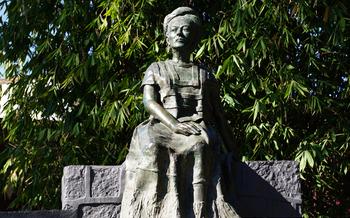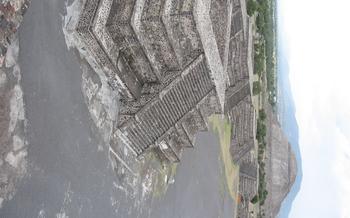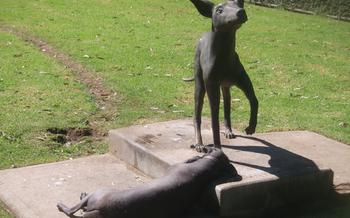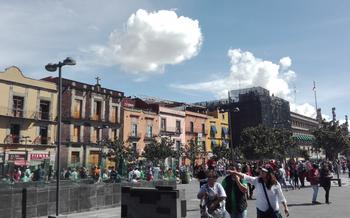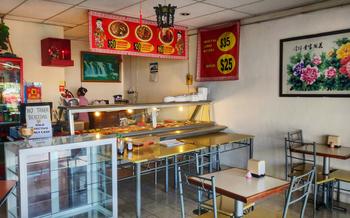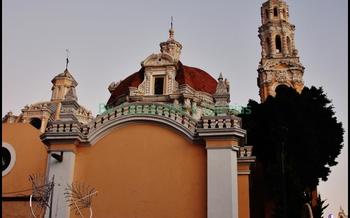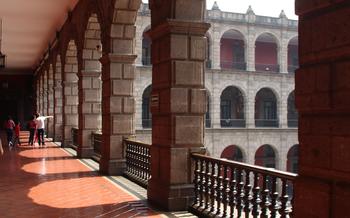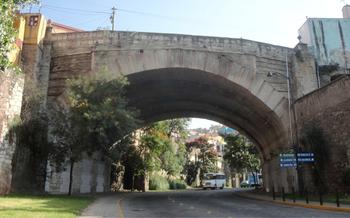
Museo Frida Kahlo (Casa Azul)
- A Visit to Frida Kahlo’s Home
- Exploring Frida’s Art
- Understanding Frida’s Life
- Navigating the Museum
- Frida Kahlo's Garden: A Sanctuary of Inspiration
- Discover Frida's Studio
- Frida’s Personal Collection
- Temporary Exhibitions
- Educational Programs
- Research Center
- Museum Store
- Events and Activities
- Accessibility
- Sustainability
- Insider Tip:
A Visit to Frida Kahlo’s Home
Step into the vibrant world of Frida Kahlo, one of Mexico's most celebrated artists, by visiting her former home and studio, now known as the Museo Frida Kahlo, or Casa Azul (Blue House). Located in the heart of Coyoacán, a picturesque neighborhood in Mexico City, the Casa Azul offers an immersive journey into Frida's life, passions, and art.
Originally built in 1904, the Casa Azul was Frida's childhood home and later became her sanctuary and lifelong residence. It was here that she found inspiration, battled personal demons, and created some of her most iconic works. The house exudes a unique charm, with its cobalt blue exterior, vibrant interiors, and personal touches that reveal Frida's creative spirit.
As you wander through the rooms, you'll be struck by the eclectic collection of artifacts and personal belongings that adorn every corner. From Frida's colorful clothing and jewelry to her medical equipment and prosthetics, these items provide a glimpse into her daily life and struggles. The walls are adorned with her paintings, sketches, and photographs, offering an intimate look into her artistic process and personal journey.
The Casa Azul is not just a museum; it's a place where Frida's presence still lingers, inviting visitors to connect with her on a deeper level. As you walk through her home, you'll feel as if you've stepped back in time, experiencing the essence of this extraordinary woman who left an indelible mark on the world of art and Mexican culture.
Exploring Frida’s Art
Frida Kahlo's artistic repertoire was as diverse as her life experiences. Her paintings showcased a range of styles, from the naïve and folk-art-inspired to the surreal and dreamlike. She experimented with various techniques, including oil on canvas, tempera on masonite, and gouache on paper.
Throughout her work, certain themes and symbols recurred, reflecting her personal struggles, cultural identity, and political beliefs. Her paintings often depicted her physical pain, emotional anguish, and the search for her own identity. She used symbolism to convey complex emotions and experiences, such as the use of thorns and wounds to represent her physical suffering.
Frida Kahlo's self-portraits were particularly powerful and revealing. She painted herself with unflinching honesty, capturing her physical and emotional states with raw intensity. These self-portraits offered a glimpse into her inner world, revealing her strength, resilience, and vulnerability.
The influence of Mexican culture and traditions was deeply embedded in Frida Kahlo's art. She drew inspiration from Mexican folk art, pre-Columbian iconography, and the vibrant colors and textures of her homeland. Her paintings celebrated Mexican identity and heritage, while also challenging traditional gender roles and societal norms.
Understanding Frida’s Life
Frida Kahlo's life was marked by both triumph and adversity. Born in Coyoacán, Mexico in 1907, she contracted polio at the age of six, which left her with lifelong health issues. Despite her physical challenges, Frida displayed a remarkable resilience and determination from a young age.
At the age of 18, Frida suffered a horrific bus accident that left her with multiple injuries, including a broken spinal column. During her long recovery, she began to paint as a way to express her pain and emotions. Her art became a powerful outlet for her to explore her identity, her physical suffering, and her complex relationship with her husband, the renowned muralist Diego Rivera.
Frida and Diego had a tumultuous relationship, marked by both love and betrayal. They married in 1929 and divorced in 1939, only to remarry a year later. Their relationship was often strained by Diego's infidelities and Frida's own health problems. However, despite their challenges, they remained deeply connected and influenced each other's artistic careers.
Frida's art and activism were closely intertwined. She was a passionate advocate for social justice and women's rights, and she often used her platform to speak out against inequality and oppression. She was also a strong supporter of the Mexican Communist Party, and she actively participated in political demonstrations and rallies.
Frida Kahlo's legacy extends far beyond her artistic achievements. She has become a global icon of resilience, creativity, and female empowerment. Her work continues to inspire and empower people around the world, and her Casa Azul in Coyoacán has become a pilgrimage site for those seeking to connect with her spirit and her art.
Navigating the Museum
Practical Information for a Smooth Visit
To ensure a seamless visit to the Museo Frida Kahlo, it's essential to be aware of practical information. The museum welcomes visitors from Tuesday to Sunday, closing on Mondays. It opens from 10 am to 5:45 pm, allowing ample time to explore the exhibits. Admission fees vary depending on your residency status, with discounted rates for students, seniors, and children.
To avoid long queues and crowds, it's advisable to plan your visit strategically. Opt for a weekday morning, as the museum tends to be less crowded during these times. If possible, avoid visiting on weekends or during school holidays when there's a higher influx of visitors.
To enhance your museum experience, consider joining a guided tour. Professional guides can provide insightful commentary on Frida Kahlo's life, art, and the significance of the Casa Azul. Audio guides are also available for a more self-paced exploration. These guides offer detailed explanations of the exhibits in various languages, allowing you to delve deeper into Frida's story.
The Museo Frida Kahlo has made significant efforts to ensure accessibility for visitors with disabilities. Wheelchair users can enter through a dedicated accessible entrance and navigate the museum with ease, thanks to ramps throughout the premises. Audio guides and visual aids are also available for visitors with hearing or visual impairments, ensuring an inclusive and welcoming environment for all.
Frida Kahlo's Garden: A Sanctuary of Inspiration
In the heart of the Casa Azul, visitors are captivated by the vibrant garden that Frida Kahlo lovingly tended to. A riot of colors and textures, the garden was an extension of Frida's creative spirit, reflecting her deep connection to nature and her Mexican heritage.
Frida's garden was a sanctuary, a place where she found solace, inspiration, and healing. Here, amidst a kaleidoscope of flowers and plants, she could escape the pain and turmoil that often marked her life. The garden was a living canvas, where Frida expressed her artistic vision through the arrangement of colors, textures, and shapes.
Among the many plants that Frida cultivated, the bougainvillea held a special place in her heart. With its vibrant purple blooms, the bougainvillea symbolized resilience and strength, qualities that Frida embodied throughout her life. The garden also featured a variety of cacti, their sharp thorns echoing Frida's own prickly exterior.
In addition to its aesthetic beauty, Frida's garden held symbolic meaning. The lush vegetation represented the fertility and abundance of Mexican culture, while the vibrant colors reflected the joy and passion that Frida found in life. The garden was a microcosm of Frida's world, a place where she could express her innermost thoughts and feelings through the language of nature.
As visitors wander through Frida's garden, they can almost feel her presence, lingering among the flowers and plants that she so lovingly cared for. It is a place of contemplation and reflection, where one can connect with Frida's spirit and gain a deeper appreciation for her life and work.
Discover Frida's Studio
Frida Kahlo's studio at the Casa Azul is a sacred space that provides a glimpse into her creative process. Immerse yourself in the environment where she poured her soul onto canvas. Observe the tools she used, from her brushes to her paints, and marvel at the materials she experimented with, such as natural pigments and unconventional surfaces. Discover the influence of her studio space on her work, as the intimate setting and personal objects served as a source of inspiration and reflection. The studio is a testament to her artistic journey, where she transformed her pain and experiences into powerful works of art.
Frida’s Personal Collection
Frida Kahlo was a passionate collector of artifacts and objects that held personal and cultural significance to her. Her extensive collection, displayed throughout the Museo Frida Kahlo, offers a glimpse into her personality, interests, and artistic influences.
Among her most cherished possessions were pre-Columbian figurines, traditional Mexican clothing, and folk art objects. These items reflected her deep appreciation for her country's rich history and heritage. Frida also collected medical artifacts and prosthetics, a nod to her lifelong struggles with physical pain and illness.
The collection also includes an eclectic mix of personal items, such as photographs, letters, and jewelry. These objects provide an intimate glimpse into Frida's personal life and relationships, revealing her loves, friendships, and challenges.
By exploring Frida's personal collection, visitors gain a deeper understanding of her as an artist, a woman, and a symbol of Mexican culture. Each object tells a story, shedding light on the complexities and passions of one of Mexico's most celebrated artists.
Temporary Exhibitions
The Museo Frida Kahlo often hosts temporary exhibitions related to Frida Kahlo and Mexican art, adding a dynamic and ever-changing element to the museum experience. These exhibitions explore a wide range of topics and themes, from the artist's personal life and artistic process to the broader context of Mexican culture and history.
Collaborations with other museums and institutions bring new perspectives and insights to the museum's programming, showcasing the work of other Mexican artists, exploring different periods of Mexican art history, or examining the influence of Frida Kahlo on contemporary art.
Temporary exhibitions play a crucial role in keeping Frida Kahlo's legacy alive and relevant to new generations of visitors. By presenting fresh perspectives and highlighting different aspects of her life and work, these exhibitions help to expand our understanding of this iconic artist and her enduring impact on the world of art.
Educational Programs
The Museo Frida Kahlo is dedicated to promoting art education and appreciation, offering a variety of educational programs and workshops for students and visitors of all ages. These programs aim to foster a creative and informed community, encouraging participants to explore Frida Kahlo's life, art, and cultural context.
The museum offers lectures, workshops, and guided tours that delve into the diverse aspects of Frida Kahlo's work and Mexican art. Through these programs, participants gain insights into Frida's artistic techniques, recurring themes, and the influences that shaped her unique style. They also explore the broader context of Mexican culture and history, understanding how Frida's art reflected the social and political landscape of her time.
The educational programs at the Museo Frida Kahlo are designed to be engaging and interactive, allowing participants to learn through hands-on experiences and discussions. Workshops may include art-making activities inspired by Frida's work, encouraging participants to express their own creativity and explore different artistic media. Guided tours provide an in-depth look at the museum's collection, offering insights into Frida's personal life, artistic process, and the significance of her work.
The museum's educational programs play a crucial role in fostering a deeper appreciation for Frida Kahlo's legacy and Mexican art. By providing opportunities for learning and exploration, the museum helps to cultivate a new generation of art enthusiasts and contributes to the preservation and promotion of Mexico's rich cultural heritage.
Research Center
The Museo Frida Kahlo is not just a place to admire the artist's work but also a hub for scholarly research. At the heart of the museum lies a dedicated research center that houses an extensive collection of books, documents, and artifacts related to Frida Kahlo and Mexican art. This treasure trove of information is a magnet for researchers and scholars from around the world, who come to delve into the life and work of this iconic figure.
The research center is committed to fostering a dynamic and collaborative environment, facilitating access to its resources and encouraging interdisciplinary research. Through its collaborations with universities, institutions, and individual scholars, the center contributes to the ongoing exploration and understanding of Frida Kahlo's art and its significance within the broader context of Mexican and global art history.
The research center's resources extend beyond the museum's walls, reaching a global audience through online databases and digital initiatives. This commitment to knowledge sharing ensures that Frida Kahlo's legacy continues to inspire and inform new generations of artists, researchers, and art enthusiasts worldwide.
Museum Store
The Museo Frida Kahlo offers a well-stocked museum store where visitors can purchase a variety of Frida Kahlo-inspired merchandise. This is a fantastic opportunity to take a piece of the Frida Kahlo experience home with you. The store features a unique and authentic selection of products, including books, postcards, posters, and various Frida Kahlo-themed souvenirs. There are also reproductions of some of her most famous paintings, as well as jewelry, clothing, and home goods inspired by her art.
The proceeds from the museum store support the museum's mission and operations, allowing it to continue preserving and sharing Frida Kahlo's legacy with the world. By making a purchase at the store, you are not only taking home a piece of Frida Kahlo's art but also contributing to the preservation of her home and studio. So, be sure to visit the museum store before you leave to find the perfect souvenir to commemorate your visit.
Events and Activities
The Museo Frida Kahlo is not just a static repository of artifacts but a vibrant and dynamic space that hosts a variety of events and activities related to Frida Kahlo and Mexican culture. These events add a layer of engagement and interactivity to the museum experience, allowing visitors to connect with the artist and her legacy in a more personal and meaningful way.
The museum regularly organizes lectures, workshops, concerts, and film screenings that explore different aspects of Frida Kahlo's life, art, and the broader context of Mexican culture. These events feature renowned experts, scholars, and artists who share their insights and perspectives on Frida's work and its significance.
Workshops and classes provide hands-on experiences for visitors to engage with Frida's artistic techniques and Mexican crafts. Visitors can learn about traditional Mexican embroidery, painting, or paper-cutting, creating their own unique artworks inspired by Frida's style.
Concerts and film screenings showcase the vibrant music and cinema of Mexico, offering visitors a chance to immerse themselves in the cultural landscape that shaped Frida's identity. These events often feature live performances by talented Mexican musicians and screenings of classic Mexican films that provide a glimpse into the country's rich cinematic heritage.
By hosting these events and activities, the Museo Frida Kahlo becomes a platform for cultural exchange and dialogue, fostering a sense of community and encouraging visitors to explore the intersections between art, history, and Mexican traditions.
Accessibility
The Museo Frida Kahlo is committed to providing accessibility for visitors with disabilities. The museum is wheelchair-accessible, with ramps and elevators throughout the building. Audio guides and visual aids are available for visitors with hearing or visual impairments. The museum staff is trained to assist visitors with disabilities and ensure they have a comfortable and enjoyable experience. The museum's commitment to accessibility reflects its belief that art and culture should be accessible to everyone, regardless of their abilities. Visitors with disabilities are encouraged to contact the museum in advance to inquire about specific accommodations or assistance they may require during their visit.
Sustainability
The Museo Frida Kahlo is committed to sustainability and environmental protection. The museum has implemented several initiatives to reduce its ecological footprint and promote sustainable practices. The museum utilizes renewable energy sources, such as solar panels, to power its operations. Additionally, the museum has adopted energy-efficient lighting and HVAC systems to minimize energy consumption. The museum also strives to reduce waste by implementing recycling programs and composting organic materials. Through these efforts, the Museo Frida Kahlo aims to create a sustainable and environmentally friendly environment for its visitors and staff.
Insider Tip:
Unveiling the Secrets of the Museo Frida Kahlo
To fully immerse yourself in the captivating world of Frida Kahlo, plan your visit to the Museo Frida Kahlo strategically. Consider visiting during the week, particularly in the morning, to avoid the throngs of tourists that often descend upon this iconic destination. This will allow you to leisurely explore the museum's treasures without feeling rushed or jostled.
Once inside, take your time to savor every detail of Frida's extraordinary life and art. Don't just rush through the rooms; instead, pause to contemplate the intricate symbolism in her paintings, the personal artifacts that reveal her struggles and triumphs, and the vibrant colors that dance across her canvases. Allow yourself to be captivated by the stories whispered by each brushstroke and the emotions poured onto every canvas.
To enhance your experience further, consider combining your visit to the museum with a leisurely stroll through the enchanting neighborhood of Coyoacán. This vibrant district, with its cobblestone streets, colorful markets, and charming cafes, was once home to Frida and Diego Rivera, and its bohemian atmosphere still lingers in the air.
As you depart from the museum, don't forget to visit the gift shop, a treasure trove of Frida-inspired souvenirs. Here, you can find a unique memento to commemorate your visit—a colorful tote bag adorned with Frida's likeness, a whimsical magnet featuring her iconic unibrow, or a beautifully illustrated book showcasing her life and work.
By following these insider tips, you'll unlock the secrets of the Museo Frida Kahlo and experience the magic of this extraordinary artist in a truly unforgettable way.
